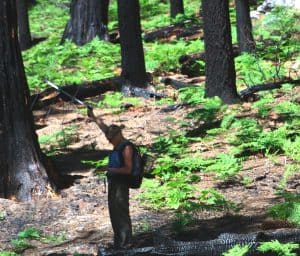Share this article
A ‘burning issue’: Spotted owls use fire mosaic
Before mega-fires like the 2013 Rim Fire burned large swaths of the landscape, Yosemite National Park had been setting smaller prescribed fires to regenerate the forest. In a study published in The Condor: Ornithological Applications, researchers looked at habitat occupation by California spotted owls (Strix occidentalis occidentalis) to see how the park’s prescribed burn program affects their conservation.
The team found that owls selected a mosaic of burned patches of different sizes and severities, although they tended to avoid the interior of badly burned areas.
“Continuing to have high-severity fire is not bad for owls as long as it’s occurring in patch sizes within the natural range of variation, embedded within a mosaic landscape,” said TWS member Stephanie Eyes, a wildlife biologist with Yosemite National Park and lead author of the study.
Because many of the team’s monitoring sites were burned by large fires such as the Rim Fire, Eyes said, researchers couldn’t investigate the impacts of these massive fires.

Stephanie Eyes performs radio telemetry to determine owl locations in Yosemite National Park. ©Scott Scherbinski
Eyes will present her research at a symposium called “Wildlife and Spotted Owls: It’s a Burning Issue” at the upcoming annual TWS conference in Albuquerque. Fifteen speakers at the symposium will discuss topics including federal fire policy and management, Native American perspectives on fire effects on spotted owls, effects of fire on Mexican spotted owls and more.
Eyes said it’s important to maintain these patches of burned areas as well as low-severity fire patches and unburned patches to sustain flying squirrels — the owl’s primary prey species — and to provide nest and roost habitat for the owls. The California spotted owl is currently under review for a federal listing decision.
“It’s really about balancing the benefits for all species involved with fire,” she said.
Eyes and her colleagues used radio transmitters to track the movements of 13 spotted owls on eight territories in the park. The team found that owls were foraging in the forest edges of high-severity fire patches, possibly because the edges provide more open space for them to fly.
She hopes the results of the study help guide management of prescribed fires. Other sensitive species that also need to be taken into consideration in the mid-elevation forests include the great gray owl and fishers, she said.
Eyes said more research needs to be done to determine how the more recent larger stand-replacing fires affect the owls. She is currently looking at the effects of the Rim Fire on spotted owl site occupancy and reproduction.
Header Image: A California spotted owl perches on a tree branch. ©Kurt Ongman








